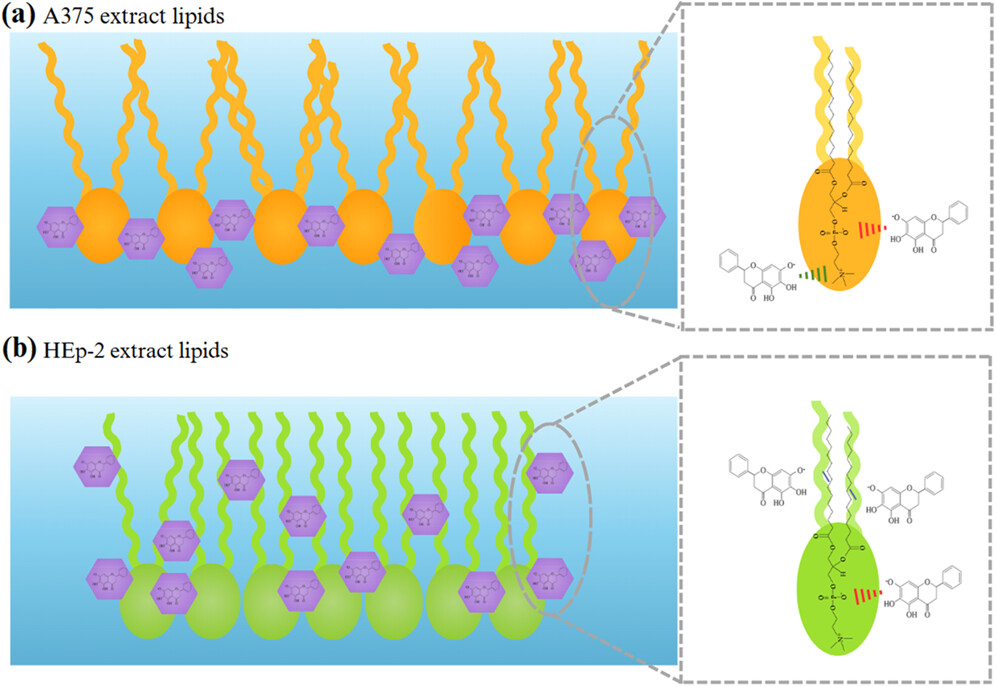 Abstract: lavonoids are known for their antioxidant, anti-inflammatory, antitumoral, and antiviral properties, as is the case for baicalein derived from the roots of Scutellaria baicalensis, which is effective against respiratory viral infections. In this study, we investigate the molecular mechanisms underlying the interaction between baicalein and Langmuir monolayers as models for cell membranes. For comparison, we analyzed monolayers from lipid extracts of two cell lines: oropharyngeal carcinoma (HEp-2), which is susceptible to respiratory viral infections, and primary melanoma (A375), which is not. Baicalein incorporation into A375 lipid extract monolayers shifted the p?A isotherms to larger areas, reducing monolayer stability. In contrast, its incorporation into HEp-2 lipid extract monolayers shifted the p?A isotherms to smaller areas, enhancing both compaction and stability. Polarization-modulation infrared reflection?absorption spectroscopy (PM-IRRAS) revealed that baicalein interactions with A375 lipid extracts involved electrostatic attractions and repulsions with choline and phosphate headgroups, disrupting chain organization and expanding the monolayer. In HEp-2 lipid extracts, baicalein interacted strongly with phosphate headgroups and lipid chains, increasing chain order and stabilizing the monolayer. These findings suggest that baicalein stabilizes HEp-2 lipid membranes, potentially providing a protective mechanism against respiratory viral infections. Its selective interaction with lipid membranes is consistent with its therapeutic potential and role in modulating membrane properties to inhibit viral entry. Abstract: lavonoids are known for their antioxidant, anti-inflammatory, antitumoral, and antiviral properties, as is the case for baicalein derived from the roots of Scutellaria baicalensis, which is effective against respiratory viral infections. In this study, we investigate the molecular mechanisms underlying the interaction between baicalein and Langmuir monolayers as models for cell membranes. For comparison, we analyzed monolayers from lipid extracts of two cell lines: oropharyngeal carcinoma (HEp-2), which is susceptible to respiratory viral infections, and primary melanoma (A375), which is not. Baicalein incorporation into A375 lipid extract monolayers shifted the p?A isotherms to larger areas, reducing monolayer stability. In contrast, its incorporation into HEp-2 lipid extract monolayers shifted the p?A isotherms to smaller areas, enhancing both compaction and stability. Polarization-modulation infrared reflection?absorption spectroscopy (PM-IRRAS) revealed that baicalein interactions with A375 lipid extracts involved electrostatic attractions and repulsions with choline and phosphate headgroups, disrupting chain organization and expanding the monolayer. In HEp-2 lipid extracts, baicalein interacted strongly with phosphate headgroups and lipid chains, increasing chain order and stabilizing the monolayer. These findings suggest that baicalein stabilizes HEp-2 lipid membranes, potentially providing a protective mechanism against respiratory viral infections. Its selective interaction with lipid membranes is consistent with its therapeutic potential and role in modulating membrane properties to inhibit viral entry. |





 Abstract: lavonoids are known for their antioxidant, anti-inflammatory, antitumoral, and antiviral properties, as is the case for baicalein derived from the roots of Scutellaria baicalensis, which is effective against respiratory viral infections. In this study, we investigate the molecular mechanisms underlying the interaction between baicalein and Langmuir monolayers as models for cell membranes. For comparison, we analyzed monolayers from lipid extracts of two cell lines: oropharyngeal carcinoma (HEp-2), which is susceptible to respiratory viral infections, and primary melanoma (A375), which is not. Baicalein incorporation into A375 lipid extract monolayers shifted the p?A isotherms to larger areas, reducing monolayer stability. In contrast, its incorporation into HEp-2 lipid extract monolayers shifted the p?A isotherms to smaller areas, enhancing both compaction and stability. Polarization-modulation infrared reflection?absorption spectroscopy (PM-IRRAS) revealed that baicalein interactions with A375 lipid extracts involved electrostatic attractions and repulsions with choline and phosphate headgroups, disrupting chain organization and expanding the monolayer. In HEp-2 lipid extracts, baicalein interacted strongly with phosphate headgroups and lipid chains, increasing chain order and stabilizing the monolayer. These findings suggest that baicalein stabilizes HEp-2 lipid membranes, potentially providing a protective mechanism against respiratory viral infections. Its selective interaction with lipid membranes is consistent with its therapeutic potential and role in modulating membrane properties to inhibit viral entry.
Abstract: lavonoids are known for their antioxidant, anti-inflammatory, antitumoral, and antiviral properties, as is the case for baicalein derived from the roots of Scutellaria baicalensis, which is effective against respiratory viral infections. In this study, we investigate the molecular mechanisms underlying the interaction between baicalein and Langmuir monolayers as models for cell membranes. For comparison, we analyzed monolayers from lipid extracts of two cell lines: oropharyngeal carcinoma (HEp-2), which is susceptible to respiratory viral infections, and primary melanoma (A375), which is not. Baicalein incorporation into A375 lipid extract monolayers shifted the p?A isotherms to larger areas, reducing monolayer stability. In contrast, its incorporation into HEp-2 lipid extract monolayers shifted the p?A isotherms to smaller areas, enhancing both compaction and stability. Polarization-modulation infrared reflection?absorption spectroscopy (PM-IRRAS) revealed that baicalein interactions with A375 lipid extracts involved electrostatic attractions and repulsions with choline and phosphate headgroups, disrupting chain organization and expanding the monolayer. In HEp-2 lipid extracts, baicalein interacted strongly with phosphate headgroups and lipid chains, increasing chain order and stabilizing the monolayer. These findings suggest that baicalein stabilizes HEp-2 lipid membranes, potentially providing a protective mechanism against respiratory viral infections. Its selective interaction with lipid membranes is consistent with its therapeutic potential and role in modulating membrane properties to inhibit viral entry. @article={003244143,author = {MARTINS, Bruna Alves; SOUSA, Giovanna Eller Silva; ALMEIDA JUNIOR, Alexandre Mendes de; TOLEDO, Karina Alves; OLIVEIRA JUNIOR, Osvaldo Novais de; CAMACHO, Sabrina Aléssio; AOKI, Pedro Henrique Benites.},title={Baicalein interactions with lipid membrane models: implications for its protective role against respiratory viral infections},journal={Langmuir},note={v. 41, n. 14, p. 9377-9385+ supporting information},year={2025}}
@article={003244143,author = {MARTINS, Bruna Alves; SOUSA, Giovanna Eller Silva; ALMEIDA JUNIOR, Alexandre Mendes de; TOLEDO, Karina Alves; OLIVEIRA JUNIOR, Osvaldo Novais de; CAMACHO, Sabrina Aléssio; AOKI, Pedro Henrique Benites.},title={Baicalein interactions with lipid membrane models: implications for its protective role against respiratory viral infections},journal={Langmuir},note={v. 41, n. 14, p. 9377-9385+ supporting information},year={2025}}